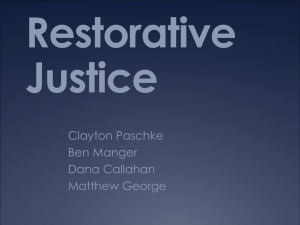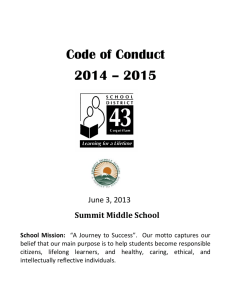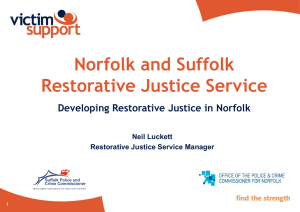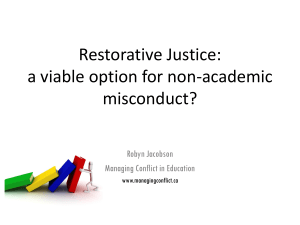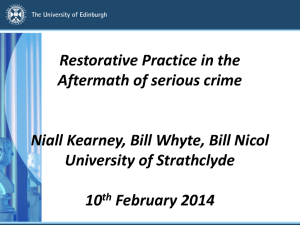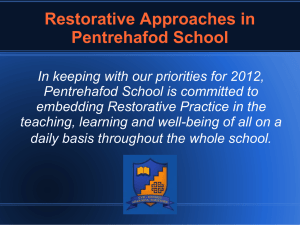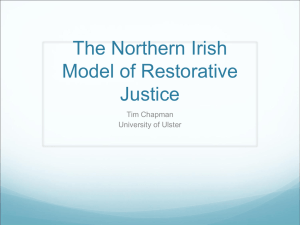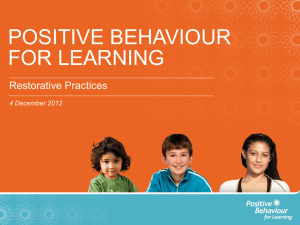Charnwood College Presentation for 2 day YOS training on
advertisement
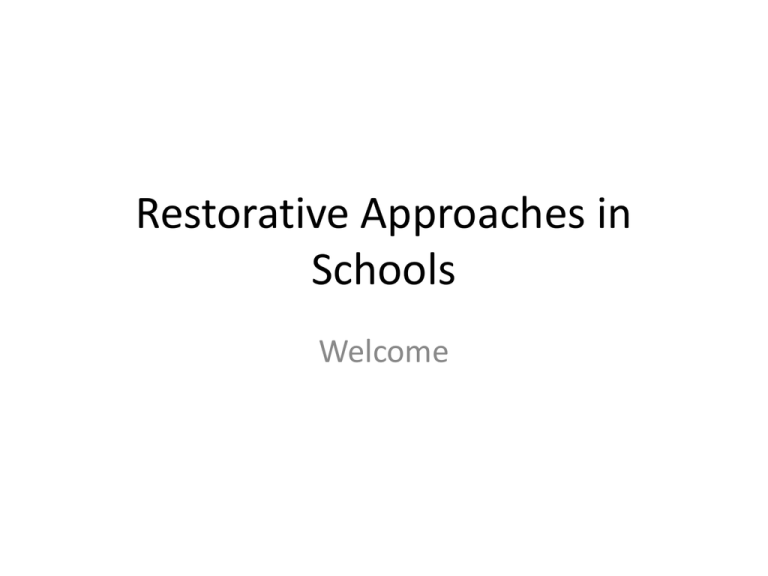
Restorative Approaches in Schools Welcome Aims and Objectives • To know what Restorative Approaches are and their origins • To be able to understand the difference between restorative and retributive interventions • To use restorative dialogue in day-to-day working • To use different restorative approaches • How to implement in your school Current understanding of Restorative Approaches/Restorative Justice (RA/RJ) Brief History of RJ • • • • • • Ancient times Loss of the victim New Zealand –FGC UK via Australia Introduced into UK Justice system Expansion into other areas LAC/Education Definitions Why Restorative Justice? • Restorative Justice is not an absolute answer for removing all ills, resolving all conflict or repairing all harm. It is not a naïve alternative to punitive sanctions or an idealistic response to offending. It is not an easy option for the offender The benefits for schools • Builds further on the culture of respect and discipline and cohesion within the school community. • Increases staff confidence to deal with a wide variety of discipline issues:- bullying, low level disruption, classroom management • Empowers students to take ownership of their behaviour to encourage self discipline and responsibility to other learners and staff in the school community • (RJC December 2011) For people in schools... For pupils • RA encourages students to take responsibility for their behaviour and relationships • RA teaches students how to manage conflict constructively • RA provides young people with valuable life skills For Teachers • Teachers have more time and energy to devote to other issues • Conflict resolution modules and training can be used as part of the curriculum PSHE and Citizenship • Classroom management is made easier as children gain improved listening skills What people say... • “It has helped to solve some very long-term intractable problems between pupils” • “RJ has helped to shift some of the pastoral staff away from punitive measures” • “I was initially a sceptic, but I have been won over by what I have seen” • “RJ has been a significant part of our move out of special measures” • Snr school staff YJB Does it work? • In Barnet, exclusions reduced by 51% in RJ schools compared with an in increase of 65% where RJ not practiced. • In Bristol, Orchard School recorded 300 permanent exclusions per year. Since RJ introduced figure fallen, year on year, to just one. • In Hull, evaluation concluded in 14 schools 73% fewer classroom exclusions, 81% fewer fixed term exclusions and 70% fewer verbal abuse towards staff and pupils. • Source RJC Briefing Dec 2011 Behaviour in schools • Good behaviour • Challenging behaviour – different levels • Current behaviour policy rewards/sanctions Negative Behaviours • • • • • • • • • Verbal abuse Physical abuse – threats or real Damage to property Theft of property Bullying and intimidation Group negative behaviour Fighting Breaking rules Absconding Dealing with Behaviours The Restorative Approach Decision What I need to do to make up for what I have done and what I need to do to stop getting into trouble Sanction/Punishment Model Decision This is what you are going to do…..and what we are going to do to you Being a victim/wronged How can we help? Whole School Approach • All evidence suggests RA works best with whole school approach PHSE, citizenship, circle time, playground buddies, peer mediation, peer mentoring. All staff included. • Use of different approaches - policy • Language • Posters around school – four ‘R’s (Respect, Responsibility, Repair, Reintegration) • Empowering victim Implementation Day 2 • Communication and Restorative Approaches Mind your (restorative) language • Attack the problem and not the pupil “You are a right pain” “What you just did is a right pain” • Focus on the positive “You haven’t finished your work yet” “Good, you have made a start, now finish it quickly please” • Use neutral language “You just won’t stop shouting” “I have noticed that you are choosing to ignore the rule of not shouting out today. If you carry on, there will be consequences” • Affirm positive behaviour “How many times do I have to tell you Sean, stop tapping that pencil” “Most of you are ready to start work, I am just waiting for one or two of you to catch up. Thanks Sean, that is better. Open Communication • • • • • • • • Active listening Power of language Tone of voice Awareness of communication styles Building rapport Body Language (70%) Respect Open questions The Five Magic Questions • • • • • What happened? What were you thinking? How were you feeling? Who else has been affected by this? What do you need, and what needs to happen now, so that the harm can be repaired ? Restorative Conversations You Other person Planning Mediation • • • • • Is it appropriate? Facilitators needs Offender/victim needs Room layout Follow up When NOT appropriate • It will make matters worse • When participants do not want to engage • When the person who caused harm does not admit behaviour • The matter is serious, sexual or domestic • When planning and risk assessment is needed • If police may prosecute Mediation • 2 or more people • Neutral facilitator Facilitator Person 1 Person 2 Restorative Processes (things to remember) • Assess to decide which approach to take • Involvement of person wronged is always voluntary • Safety of person wronged – physical, emotional, on-going is paramount • Involvement only if in wronged persons best interests • Wronged person can end process at any point Key things that are different • Young person to clearly understand impact of their behaviour • Young person involved in agreeing reparation / restoration • Staff asked to discuss impact on themselves How RA works in schools • Develops a common language to manage conflict and enable positive communication • Creates a way to see our behaviours • Allows us to recognise how our behaviours affect others • Creates a responsibility to learn from conflict • Educates participants in producing positive outcomes from challenging situations DVD The Ripple Effect Further info/support • • • • • www.youth-justice-board.gov.uk www.restorativesolutions.org.uk www.restorativejustice.org.uk/?p=resources&search=Schools www.teachingexpertise.com/articles/restorative-justice-696 www.restorative justice4schools.co.uk


